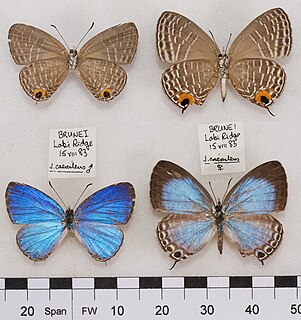
Jamides caerulea, the royal cerulean, is a small butterfly that belongs to the lycaenids or blues family. It was described by Herbert Druce in 1873. It is found in the Indomalayan realm.

Cupidesthes is a genus of butterflies in the family Lycaenidae. The species of this genus are found in the Afrotropical realm. The genus Cupidesthes was erected by Per Olof Christopher Aurivillius in 1895.

Pilodeudorix is a genus of butterflies in the family Lycaenidae. They are found in the Afrotropical realm.
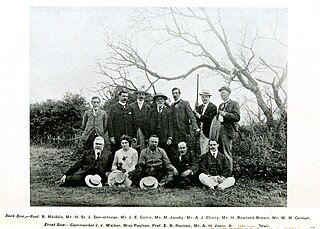
Hamilton Herbert Charles James Druce was an English entomologist who specialised in Lycaenidae and to a lesser extent Hesperiidae. He is not to be confused with his father, the English entomologist Herbert Druce (1846–1913) who also worked on Lepidoptera.
Pilodeudorix mimeta, the green-and-orange playboy, is a butterfly in the family Lycaenidae. It is found in Nigeria, Cameroon, Gabon, the Republic of the Congo, the Central African Republic, the Democratic Republic of the Congo, Tanzania and Zambia. The habitat consists of primary forests.

Pilodeudorix virgata, the small green-streaked playboy, is a butterfly in the family Lycaenidae. The species was first described by Hamilton Herbert Druce in 1891. It is found in Sierra Leone, Liberia, Ivory Coast, Ghana, Nigeria, Cameroon, Gabon, the Republic of the Congo, the Central African Republic, the northern half of the Democratic Republic of the Congo and Uganda. The habitat consists of forests.

Pilodeudorix kafuensis is a butterfly in the family Lycaenidae. It is found in Zambia, the Democratic Republic of the Congo, Malawi and south-western Tanzania. The habitat consists of primary forests.

Pilodeudorix otraeda, the original round-spot, is a butterfly in the family Lycaenidae. It is found in Guinea, Sierra Leone, Ivory Coast, Ghana, Nigeria, Cameroon, Gabon, the Republic of the Congo, the Central African Republic, the Democratic Republic of the Congo, Uganda, Tanzania and Zambia. The habitat consists of primary forests.
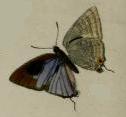
Pilodeudorix obscurata, the obscure blue-heart playboy, is a butterfly in the family Lycaenidae. It is found in Ethiopia, Kenya, Tanzania, Zambia, Mozambique, Zimbabwe and Namibia. The habitat consists of savanna.

Pilodeudorix camerona, the tufted green-streaked playboy, is a butterfly in the family Lycaenidae. It is found in Guinea, Sierra Leone, Liberia, Ivory Coast, Ghana, Togo, Nigeria, Cameroon, Gabon, the Republic of the Congo, the Central African Republic, the Democratic Republic of the Congo, Uganda, Kenya, Tanzania, Malawi and Zambia. The habitat consists of savanna.
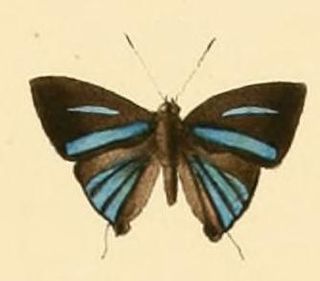
Pilodeudorix diyllus, the green-streaked playboy, is a butterfly in the family Lycaenidae. It is found in Senegal, the Gambia, Guinea, Sierra Leone, Liberia, Ivory Coast, Ghana, Togo, Nigeria and Cameroon. The habitat consists of forests.
Pilodeudorix zeloides, the midnight-blue playboy, is a butterfly in the family Lycaenidae. It is found in Uganda, western Tanzania, Malawi, Zambia, Mozambique and eastern Zimbabwe.
Pilodeudorix aurivilliusi, the Aurivillius' diopetes, is a butterfly in the family Lycaenidae. It is found in Guinea-Bissau, Sierra Leone, Ivory Coast, Liberia, Ghana and Togo. The habitat consists of forests.

Pilodeudorix kedassa is a butterfly in the family Lycaenidae first described by Hamilton Herbert Druce in 1910. It is found in Cameroon.

Pilodeudorix pasteon is a butterfly in the family Lycaenidae first described by Hamilton Herbert Druce in 1910. It is found in Cameroon, the Democratic Republic of the Congo and western Uganda.
Pilodeudorix violetta, the violet diopetes, is a butterfly in the family Lycaenidae. It is found in Guinea, Sierra Leone, Liberia, Ivory Coast, Ghana, southern Nigeria, Cameroon, Gabon, the Republic of the Congo, the Central African Republic, the Democratic Republic of the Congo (Uele), Uganda and north-western Tanzania.
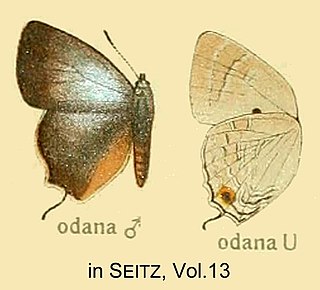
Deudorix odana, the indigo playboy, is a butterfly in the family Lycaenidae. The species was first described by Hamilton Herbert Druce in 1887. It is found in Senegal, Guinea, Sierra Leone, Ivory Coast, Ghana, Nigeria, Cameroon, the Republic of the Congo, the Central African Republic, the Democratic Republic of the Congo, Uganda, western Kenya and north-western Tanzania. The habitat consists of primary forests.
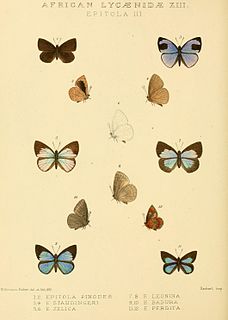
Cephetola pinodes, or Druce's epitola, is a butterfly in the family Lycaenidae. The species was first described by Hamilton Herbert Druce in 1890. It is found in Sierra Leone, Ivory Coast, Ghana, Nigeria, Cameroon, the Republic of the Congo, the Central African Republic, the Democratic Republic of the Congo, Uganda and Tanzania.

Spalgis lemolea, the lemolea harvester or African apefly, is a butterfly in the family Lycaenidae. The species was first described by Hamilton Herbert Druce in 1890. It is found in Senegal, the Gambia, Guinea-Bissau, Guinea, Liberia, Ivory Coast, Ghana, Togo, Nigeria, Cameroon, from Gabon to Ethiopia, the Democratic Republic of the Congo, Uganda, Kenya, Malawi, Zambia, northern Zimbabwe and Botswana. The habitat consists of forests and dense savannah, as well as thick riverine bush.










